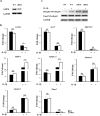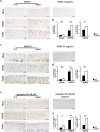AMPK deficiency in chondrocytes accelerated the progression of instability-induced and ageing-associated osteoarthritis in adult mice
- PMID: 28225087
- PMCID: PMC5320548
- DOI: 10.1038/srep43245
AMPK deficiency in chondrocytes accelerated the progression of instability-induced and ageing-associated osteoarthritis in adult mice
Abstract
Osteoarthritis (OA) is a progressive degenerative disease of the joints that is associated with both joint injury and ageing. Here, we investigated the role of the energy sensor AMP-activated protein kinase (AMPK) in maintaining a healthy state of articular cartilage and in OA development. Using cartilage-specific, tamoxifen-inducible AMPKα1 conditional knockout (AMPKα1 cKO), AMPKα2 conditional knockout (AMPKα2 cKO) and AMPKα1α2 conditional double knockout (AMPKα cDKO) mice, we found that compared with wild-type (WT) littermates, mutant mice displayed accelerated severity of surgically induced OA, especially AMPKα cDKO mice. Furthermore, male but not female AMPKα cDKO mice exhibited severely spontaneous ageing-associated OA lesions at 12 months of age. The chondrocytes isolated from AMPKα cDKO mice resulted in an enhanced interleukin-1β (IL-1β)-stimulated catabolic response. In addition, upregulated expression of matrix metalloproteinase-3 (MMP-3), MMP-13 and phospho-nuclear factor-κB (phospho-NF-κB) p65 and increased levels of apoptotic markers were detected in the cartilage of AMPKα cDKO mice compared with their WT littermates in vivo. Thus, our findings suggest that AMPK activity in chondrocytes is important in maintaining joint homeostasis and OA development.
Conflict of interest statement
The authors declare no competing financial interests.
Figures







Similar articles
-
Inhibition of cartilage degradation and suppression of PGE2 and MMPs expression by pomegranate fruit extract in a model of posttraumatic osteoarthritis.Nutrition. 2017 Jan;33:1-13. doi: 10.1016/j.nut.2016.08.004. Epub 2016 Sep 2. Nutrition. 2017. PMID: 27908544 Free PMC article.
-
Disruption of Sirt1 in chondrocytes causes accelerated progression of osteoarthritis under mechanical stress and during ageing in mice.Ann Rheum Dis. 2014 Jul;73(7):1397-404. doi: 10.1136/annrheumdis-2012-202620. Epub 2013 May 30. Ann Rheum Dis. 2014. PMID: 23723318
-
Lithium protects against cartilage degradation in osteoarthritis.Arthritis Rheumatol. 2014 May;66(5):1228-36. doi: 10.1002/art.38373. Arthritis Rheumatol. 2014. PMID: 24470226
-
Molecular regulation of articular chondrocyte function and its significance in osteoarthritis.Histol Histopathol. 2011 Mar;26(3):377-94. doi: 10.14670/HH-26.377. Histol Histopathol. 2011. PMID: 21210351 Review.
-
Age and frailty as risk factors for the development of osteoarthritis.Mech Ageing Dev. 2019 Jun;180:21-28. doi: 10.1016/j.mad.2019.03.003. Epub 2019 Mar 18. Mech Ageing Dev. 2019. PMID: 30898635 Review.
Cited by
-
Transglutaminase-2 regulates Wnt and FoxO3a signaling to determine the severity of osteoarthritis.Sci Rep. 2020 Aug 6;10(1):13228. doi: 10.1038/s41598-020-70115-w. Sci Rep. 2020. PMID: 32764573 Free PMC article.
-
Metformin Prevents or Delays the Development and Progression of Osteoarthritis: New Insight and Mechanism of Action.Cells. 2022 Sep 27;11(19):3012. doi: 10.3390/cells11193012. Cells. 2022. PMID: 36230974 Free PMC article. Review.
-
Promotion and Mechanism of Acupotomy on Chondrocyte Autophagy in Knee Osteoarthritis Rabbits.Chin J Integr Med. 2024 Sep;30(9):809-817. doi: 10.1007/s11655-024-3759-8. Epub 2024 Jun 20. Chin J Integr Med. 2024. PMID: 38900226
-
Gene expression and immune infiltration analysis comparing lesioned and preserved subchondral bone in osteoarthritis.PeerJ. 2024 May 28;12:e17417. doi: 10.7717/peerj.17417. eCollection 2024. PeerJ. 2024. PMID: 38827307 Free PMC article.
-
Emerging technology has a brilliant future: the CRISPR-Cas system for senescence, inflammation, and cartilage repair in osteoarthritis.Cell Mol Biol Lett. 2024 May 2;29(1):64. doi: 10.1186/s11658-024-00581-x. Cell Mol Biol Lett. 2024. PMID: 38698311 Free PMC article. Review.
References
-
- Aigner T., Sachse A., Gebhard P. M. & Roach H. I. Osteoarthritis: pathobiology-targets and ways for therapeutic intervention. Adv. Drug Deliv. Re. 58, 128–149 (2006). - PubMed
-
- Steinberg G. R. & Kemp B. E. AMPK in Health and Disease. Physiol. Rev. 89, 1025–1078 (2009). - PubMed
-
- Salminen A. & Kaarniranta K. AMP-activated protein kinase (AMPK) controls the aging process via an integrated signaling network. Ageing Res. Rev. 11, 230–241 (2012). - PubMed
Publication types
MeSH terms
Substances
LinkOut - more resources
Full Text Sources
Other Literature Sources
Medical
Molecular Biology Databases
Miscellaneous

